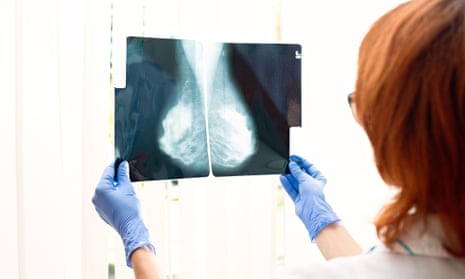In July 2022, I was diagnosed with stage three breast cancer after having had a “normal” mammogram just nine months earlier at the age of 42. Other than a small thyroid disorder, I have been extraordinarily healthy my entire life, running half marathons, practicing yoga and doing a 30-mile backpacking trek only two months earlier. I had no known family history and never missed a screening in my short life of mammography.
So how did the cancer advance so far without detection, despite top-notch medical care in one of the biggest cities in America? The answer for me and millions of other women is the dense breast phenomenon – which, at long last, is finally becoming a part of the conversation around women’s health.
Dense breast tissue is simply tissue that is thicker and glandular, hasn’t turned into fat over time, and it puts women at an automatic four times higher risk of cancer. Approximately half of women have dense breasts. What’s more, both dense breast tissue and cancer show up as white in a mammogram, which means that mammograms are unable to properly see 40-50% of dense breast tissue. In other words, looking for cancer on a mammogram with dense breasts is like trying to find a snowball in a blizzard. However, additional screenings such as ultrasound or MRI increase the sensitivity of that image to over 90-95%, making it easier to spot masses.
Yet the decision to supplement a mammogram with this additional screening is, shockingly, one of the largest controversies in women’s health; the question has essentially been left to the patient, who knows little about it and is inconsistently communicated between the original doctor (who orders the mammogram) and the radiologist (who reads it). Even worse, very few insurance plans pay for the additional screening. So what are we left with? A reality in which millions of people with breasts – which is to say, everyone – are left uninformed, uncovered and unprotected against early detection for breast cancer.
This is significant: early detection is the difference between a small procedure or the loss of your breasts; the difference between a pill every day or months of chemotherapy and radiation with long-term side-effects; the difference between a chronic issue that is dealt with using medication, or a life-threatening prognosis.
Dr Paula Gordon, a clinical professor at the University of British Columbia and a world expert on breast density, put it to me this way: “If women with dense breasts are only offered mammography, they are being discriminated against.”
In March 2023, the Food and Drug Administration announced a new policy that addresses part of the problem. New guidelines will soon require a woman’s mammogram report to include clear language informing the patient if they have dense breasts and to recommend speaking with their providers about what this means for their cancer risk.
While a great step in the right direction, this is, in essence, a more detailed version of what 38 states currently have in a “notification system” that has never gone far enough. Not only do these new guidelines seem to still punt the problem to the original ordering physician, who often has little training in this field of medicine, but it also punts the responsibility, once again, to the patient to advocate for herself on the basis of information that she may not fully understand, even with this new additional language. And since insurance coverage is outside the FDA’s purview here, it still does not require that companies pay for the screening.
Before the announcement, I spoke with Dr Robyn Gartner Roth, a board-certified radiologist specializing in breast imaging at Cooper University hospital, who also runs the popular social media account, @theboobiedocs. She said, “A major problem with breast cancer screening in general is that there are conflicting guidelines and confusing recommendations, most of which is politically driven. Additionally, most ordering physicians are not trained in breast cancer detection and treatment, so there is widespread confusion amongst doctors and patients alike.”
By no fault of their own, ordering physicians – who may work in family practice, internal medicine and even OB-GYN – are simply not trained in breast imaging, breast density, or even the proper risk assessment, which Dr Roth recommends women complete by age 30. Many take their cues largely from the United States Preventive Services Task Force (USPSTF), which doesn’t even recommend mammography until age 50, does not endorse supplemental screening, and of note, has no radiologists on the taskforce.
So, while this new FDA announcement is indeed an initial victory for women’s healthcare, and will hopefully start to shift the standard of care surrounding screening and dense breast tissue, let’s not celebrate prematurely and settle for the bare minimum – a refrain that has all too commonly played out with anything relating to women’s rights, women’s healthcare or otherwise.
We must continue to work towards automatic supplemental screening for all women with dense breast tissue, rather than rely on faulty communication in the medical system and outdated guidelines. Ultimately, we must ensure complete and comprehensive insurance coverage. With breast cancer affecting one in eight women, we cannot afford to stop now.
Elizabeth L Silver is the author of the forthcoming novel The Majority (Riverhead), as well as the novel The Execution of Noa P Singleton and the memoir The Tincture of Time. Also an attorney, she teaches creative writing with the UCLA Writers Program and lives in Los Angeles with her family
